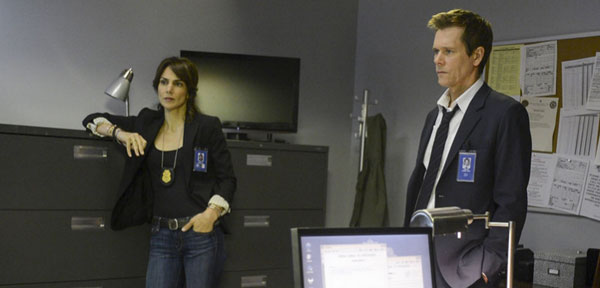
Kevin Bacon in The Following. (Copyright Fox.)
The February cultural slump has set in, a lull between the new show premieres and the Oscars and book awards at the end of the month. To pass the time I’ve been catching up Fox’s new ultraviolent attempt at a hit, The Following. It stars Kevin Bacon as an FBI investigator hunting a serial killer played by James Purefoy. Purefoy’s killer is a former Poe scholar, if one given to rather simple readings of Poe’s work. (There’s a lot of blather framed in blood metaphors, i.e., “it will bleed into your work.”) And through some kind of virtuoso hackery he has become a kind of cult leader on the Internet, with minions now carrying out his violent plan with self-conscious artfulness.
Perhaps for some that does not announce itself as an irresistible premise. I myself began watching out of what is either pity or schadenfreude for Kevin Bacon, I haven’t decided. (He’s a cautionary tale for would-be weekend venture capitalists. Invest it all in Madoff, and in your 50s you’ll find yourself doing crappy network procedurals to keep the lights on!) But it’s also because I have, and share with what I suspect is a large proportion of Americans, an embarrassing fascination with serial killer stories.
But only three episodes in with The Following, already it’s work to keep going. The scripting is inept, the acting barely competent. The cult-by-social-media concept, which in more intelligent hands could have been a nice metaphor for the way that violence creeps into the smaller corners of American life, is too literal to be interesting.
Yet this kind-of-crappy show does, unintentionally, raise the interesting questions about what kinds of violence American culture is willing to confront, and which it isn’t. As the critic Maggie Nelson recently remarked in her The Art of Cruelty, it feels “Tipper-Gore-esque” to even complain about the seriousness of violence in popular culture these days. Wall-to-wall coverage of ultimately-fictional satanic panics and trenchcoat mafias has made us cynics. It’s just that instead of being a matter of television glorifying violence in any real way, it feels like we’re being spoonfed ersatz catharsis these days. You might feel that you’re confronting the horror, but instead you’re just glossing over the real problems at the heart of it.
For example, The Following derives most of its claim to creepiness from buckets of blood and guts. Critics, on reviewing the first few episodes, dutifully remarked on the gratuitousness of it all. Willa Paskin, at Salon, described her experience of watching the first four episodes as “nauseous.” Fair enough; viscera can be gross. But curious thing sometimes happens when we take gore as a stand-in for atmosphere, like Alessandra Stanley at The New York Times seemed to. She argued that because the show was “bleak and relentlessly scary,” it was taking its violence seriously. But is the chief problem with violence that it is gross, or “scary?” Is the “scariness” of violence the way to get people to turn in their guns? Or does it make them cling to them?
Popular
"swipe left below to view more authors"Swipe →
The claim to “bleakness” begins to fall apart too, once you see how directly The Following embodies our cultural fetish for a particular kind of “innocent-looking” young white woman victim. The choice of Poe as reference point reflects that. He, too, was fascinated by dead, idealized women, memorializing his lost Lenores and Annabel Lees in beautiful poetry that bore the marks of fetish. So far, nearly every victim the show has depicted is a rote sort of co-ed, blonde as often as not. Damsels in distress provide the proper “dramatic” contrast, between pure good and pure evil. They have done so since the days of the Romantics, who invented this whole idea of murder as an art, an expression of something.
Well, one might say, there ought to be drama in a television show, oughtn’t there? Sure, but our preferences on that score have leaked into fact, the more the news feels some vague impulse to “entertain.” This has concrete effects. Missing White Woman Syndrome is now a widely used term; we are aware of the (real) news media’s obsession with damsels in distress. Their single-mindedness has a habit of eclipsing coverage of the other kinds of violence plaguing America.
Consider, after all, that real-life serial killers do not generally work on a casting director’s schematic. Their victims tend to be, systematically, people who live on the fringes of power. The most obvious category of those are sex workers, the victims both of Jack the Ripper and Robert Pickton. Many of John Wayne Gacy’s male victims fell in that category, too. Even Ted Bundy, who had more of an attraction to the media-friendly co-ed, often picked up runaways.
And it isn’t just the victims who bear no resemblance to real violence. In a funny way, the serial killer narrative feels a bit dated. It has been a long time since the heartland, as one might put it, was terrorized by one. Jeffrey Dahmer died in prison nearly twenty years ago. There are perhaps others operative, I’m not up on the latest investigations. But the terror that plagues Americans today is something more akin what happened last December 14. That is the specter of violence that’s truly haunting us. Yet somehow there is something more unspeakable in James Holmes or Jared Loughner or Adam Lanza than in a crazy guy who rants about Poe and orders beautiful young people around. It’s just not the story America wants to tell itself about itself.
Read Michelle Dean's take on the legacy of Liz Lemon.


